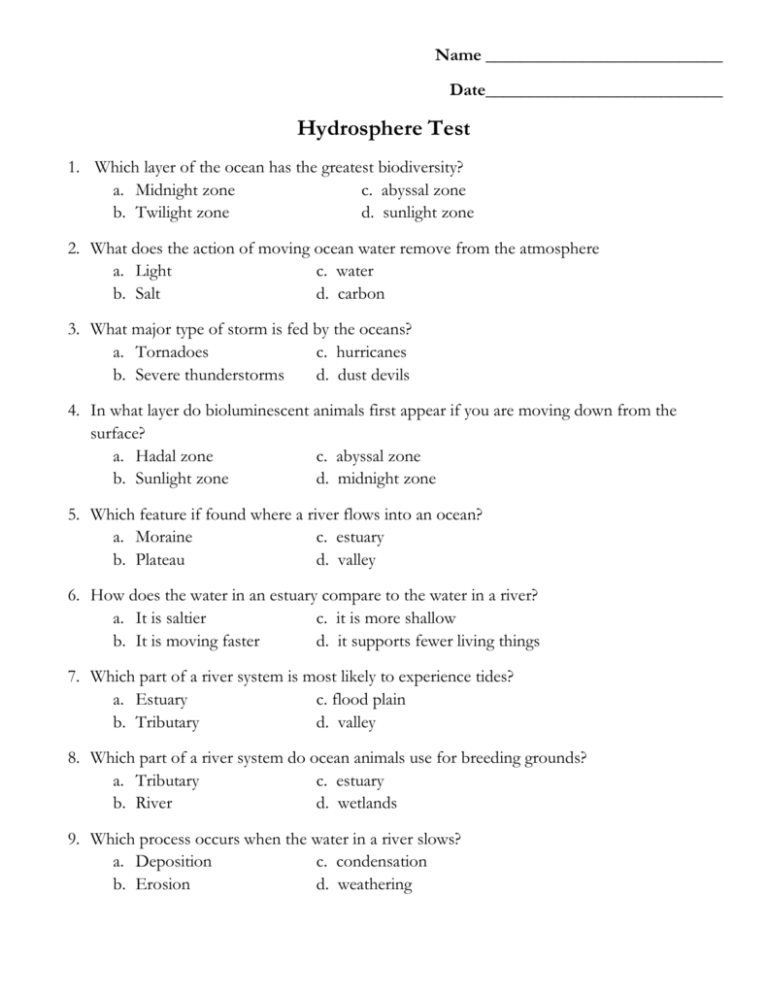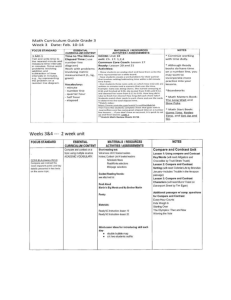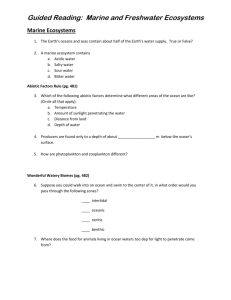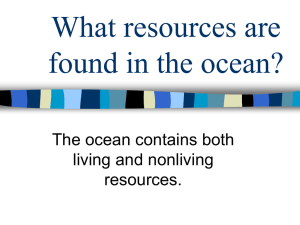Name Date___________________________ Hydrosphere Test
advertisement

Name ___________________________ Date___________________________ Hydrosphere Test 1. Which layer of the ocean has the greatest biodiversity? a. Midnight zone c. abyssal zone b. Twilight zone d. sunlight zone 2. What does the action of moving ocean water remove from the atmosphere a. Light c. water b. Salt d. carbon 3. What major type of storm is fed by the oceans? a. Tornadoes c. hurricanes b. Severe thunderstorms d. dust devils 4. In what layer do bioluminescent animals first appear if you are moving down from the surface? a. Hadal zone c. abyssal zone b. Sunlight zone d. midnight zone 5. Which feature if found where a river flows into an ocean? a. Moraine c. estuary b. Plateau d. valley 6. How does the water in an estuary compare to the water in a river? a. It is saltier c. it is more shallow b. It is moving faster d. it supports fewer living things 7. Which part of a river system is most likely to experience tides? a. Estuary c. flood plain b. Tributary d. valley 8. Which part of a river system do ocean animals use for breeding grounds? a. Tributary c. estuary b. River d. wetlands 9. Which process occurs when the water in a river slows? a. Deposition c. condensation b. Erosion d. weathering 10. What is a tributary? a. A stream that drains into a river b. The mouth of a river c. A low-lying area that is saturated with water d. A V-shaped valley carved by a river 11. To live in the abyssal zone, what must an animal be able to do? a. Hide from the many species of predators found there. b. Resist the greatest pressure c. Produce its own food through photosynthesis d. Swim quickly back to the surface 12. By which process do rivers carve valleys over many years? a. Deposition c. precipitation b. Erosion d. weathering 13. What water cycle process moves water from land to streams? a. Precipitation c. condensation b. Evaporation d. runoff 14. What causes the drainage of water from a watershed to a river? a. Heat c. gravity b. Sunlight d. Earth’s rotation 15. What is a watershed? a. A land area that drains into a river system b. An area that is always saturated with water c. An area where freshwater and saltwater mix d. A V-shaped valley carved by a river 16. In what layer are deep-sea trenches? a. Hadal zone c. abyssal zone b. Sunlit zone d. midnight zone 17. What is a wetland? a. All of the land area surrounding a river system b. The area at a river’s mouth where fresh water meets salt water c. A low-lying area that is saturated with water d. An area on the side of a river that floods periodically 18. How do wetlands improve water quality in a river system? a. Trapping sediment c. breaking down nutrients b. Filtering nutrients d. all of the above 19. What do scientists use to map the ocean floor? a. Sonar c. submersibles b. Sondes d. scuba 20. Why can’t divers explore the deep ocean floor? a. They have no way to breathe underwater b. There is nothing to explore c. There is too much pressure d. There are dangerous animals 21. Why are oceans important to people? a. They provide useful resources and livelihoods for many people. b. They are the primary source of salt for the world’s people. c. They provide drinking water to many coastal communities. d. They prevent the formation of destructive storm systems. 22. What do manufacturer use algae for? a. Thickeners c. packaging b. Calcium d. fish 23. What resource do people drill into the ocean floor for? a. Salt c. aluminum b. Calcium d. oil 24. In which part of an ocean ecosystem is the greatest diversity of organisms found? a. Lake c. coral reef b. River d. estuary 25. Which aquatic ecosystem contains the least amounts of saltwater? a. Ocean c. coral reef b. Lake d. intertidal zone 26. What is the energy source of algae? a. Tadpoles c. water fleas b. Turtles d. sun 27. What is the benthic zone? a. The part of an ocean or lake near the surface b. The part of an ocean or lake near the bottom c. The middle part of an ocean or lake d. The warmest part of an ocean or lake 28. Which is not a freshwater ecosystem? a. Pond c. river b. Sea d. stream 29. Organisms that live in the deepest depths of the ocean _________________. a. Do not need oxygen b. Come up to the surface frequently to breathe c. Live without any sunlight d. Feed only on minerals 30. In what type of biome do fish, algae, and whales live? a. Aquatic c. tundra b. Rain forest d. desert 31. Identify the true statement regarding aquatic biomes. a. An aquatic biome is found only in saltwater b. An aquatic biome is found only in freshwater c. An organism that lives in an aquatic biome lives on land d. An aquatic biome may be found in freshwater or saltwater. 32. Which of the following is the largest biome on Earth? a. Tropical rain forest c. saltwater b. Freshwater d. grasslands 33. Photosynthetic organisms cannot survive a. In the deepest parts of the ocean b. Close to the surface of the ocean c. In lakes d. Anywhere in the ocean 34. Limiting the amount of human waste and chemicals in run-off will decrease a. Air pollution c. water pollution b. Soil pollution d. sound pollution 35. More total water pollution in North Carolina comes from stormwater runoff in a. Agricultural areas c. developed areas b. Industrial areas d. wooded area 36. Water from the Cape Fear River in North Carolina was monitored over a three month period, from March through May. Monitoring was a result of extensive construction along the river. Containers show the average turbidity by month: March, April, and May. Average precipitation was greatest during May. Which of these statements is a reasonable inference about the increase in water turbidity? a. Decreased water flow due to decreased precipitation can increase turbidity. b. The cooler months bring greater human activity on the river and that increases turbidity c. Since the Cape Fear River runs down to the Atlantic Ocean, we would expect turbidity to increase. d. The drastic change in turbidity may have come from run-off from construction sites along the river. 37. This North Carolina industry is the fastest growing in the United States. In addition to providing jobs and economic stability, it also produces unregulated amounts of wastes that directly impact local water sources. This includes contaminated drinking water, algal blooms, massive fish kills, and toxic algal outbreaks. The industry that is the source of this water pollution in North Carolina in the ____________industry. a. Cattle b. Swine c. timber d. tobacco 38. One day, Carols noticed a large school of fish that had washed up dead on the shore of the lake. Curious, he took some lake water and measured its pH. He found that the lake had a pH of 4. What does this mean? a. b. c. d. The lake has a perfectly normal pH. The lake has been polluted and become basic. The lake has been polluted and become acidic The lake has a dissolved oxygen level that is too acidic. 39. One of the reasons it is important to keep our water supplies pollution free is potability. Water that is potable is a. Polluted c. fit to drink b. Oxygenated d. unfit to drink. 40. After carrying out some tests at a local stream, you discover that the pH in the stream is extremely low. Based on this, you should tell your friends to a. Go home and play xbox b. Build a raft to raft down the stream c. Swim in and drink the water from the stream d. Not swim in or drink the water from the stream 41. It is important for us to keep our water supply clean and chemically balanced, so that it is potable and we can drink it. Having the right pH level is a part of this. What pH level should drinking water have? a. 1 c. 7 b. 3 d. 13 42. What is point source pollution of an aquatic ecosystem? a. Pollution of freshwater sources b. Pollution from many sources that combine into one c. Pollution that occurs over a wide area; water that runs off from fields, parking lots, and other land surfaces d. Pollution that can easily be identified with a single discharge source, such as an open pipe which drains into a body of water. 43. A problem caused by the overuse of fertilizers that results in algal blooms like this is known as a. Red tide c. eutrophication b. Decomposition d. nutrient upload 44. About 3% of the water on Earth is freshwater. Only about 40% of that freshwater is available for human use. Why is so much freshwater unavailable for human use? A) It is frozen. B) It is polluted. C) It is salt water. D) It is in aquifers 45. Earth’s water is mostly A) saline. B) freshwater. C) fresh ground water. D) fresh surface water. 46. Coastal upwelling zones are home to numerous species because the water coming off the bottom of the ocean is A) B) C) D) oxygen-rich. nutrient-rich. warmer than the surface water. less dense than the surface water. 47. Rank the following types of water on Earth, from lowest salinity to highest salinity. A) B) C) D) salt water; brackish water; fresh water fresh water; brackish water; salt water fresh water; salt water; brackish water salt water; fresh water; brackish water 48. Which marine ecosystem has the fewest available nutrients and the lowest productivity? A) estuaries B) open ocean C) coral reefs D) continental shelf Bonus (+2) Based on the data in the pie chart, what is one conclusion that can be made about water use in the United States? A) 75% of ground water withdrawals come from only 12 of the 50 states. B) 75% of ground water withdrawals comes from 38 of the 50 states. C) There is an uneven distribution of water in the United States. D) Many states in the United States are in a drought situation. Bonus (+2) Inorganic fertilizers have a positive effect on agricultural crops but can adversely affect surrounding areas. What is a negative result of increased inorganic fertilizer run-off into ponds and lakes? a. It changes the dynamics of local food webs and results in an excess of consumers. b. It leads to an increase in the amount of dissolved oxygen in the ponds, allowing more organisms to grow. c. It increases the amount of algae present in the ponds, eventually leading to the death of other species. d. The nutrients accumulate at the bottom of the ponds because water plants are incapable of absorbing them.







